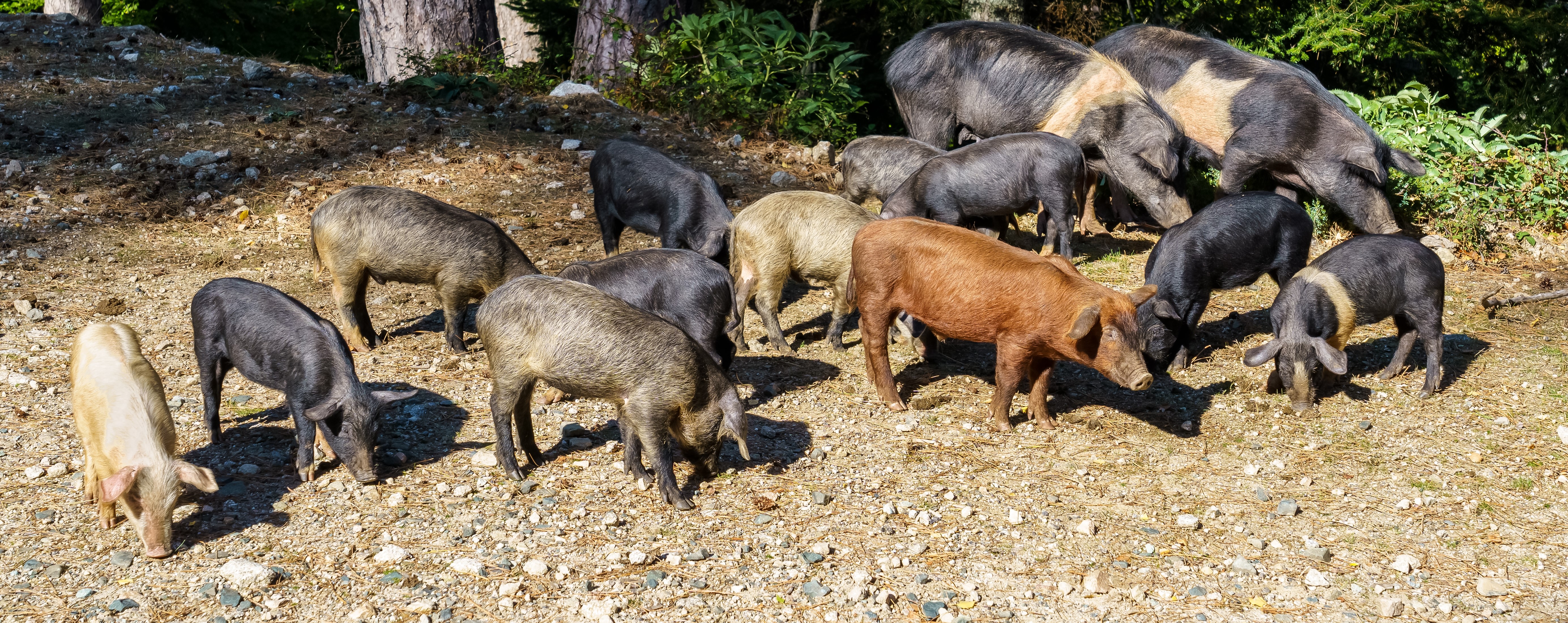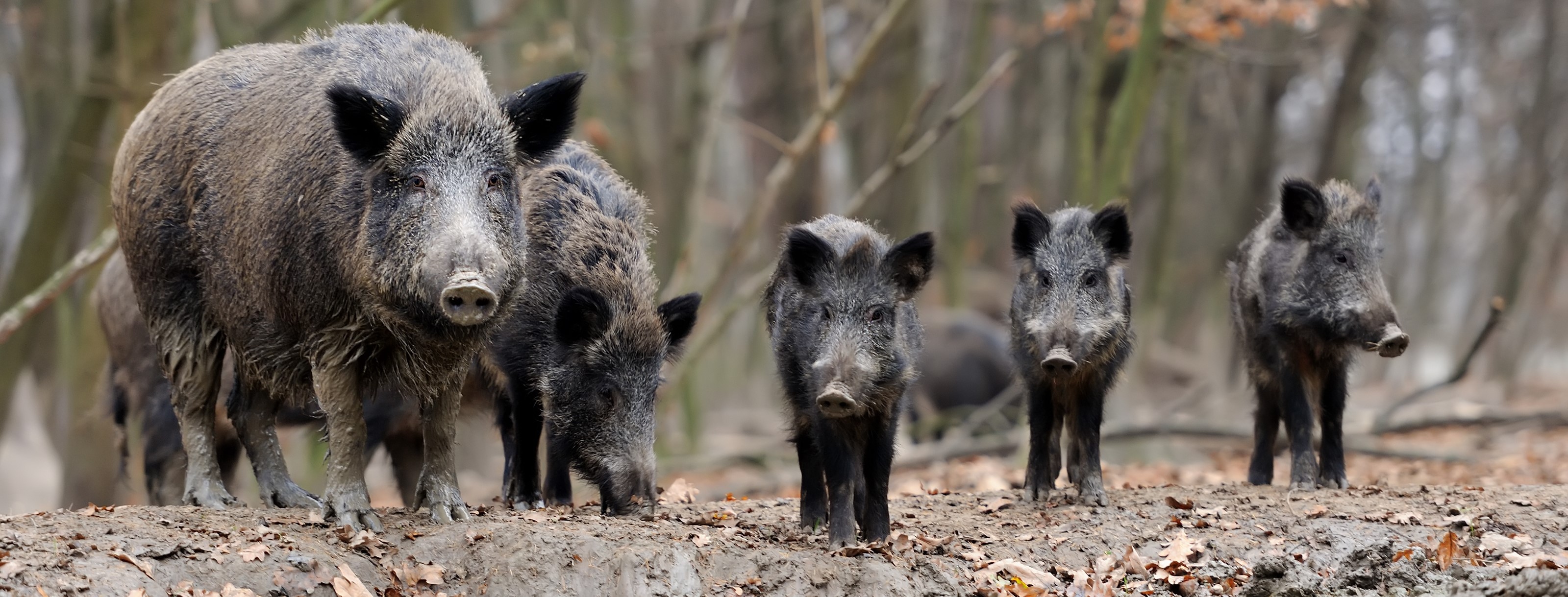| Scientific name: | Sus scrofa |
| French name: | Les porcs sauvages, les cochons sauvages, les sangliers en liberté |
| Common name(s): | Wild pigs, wild boar, wild swine, wild hogs, feral pigs, feral swine, feral hogs, Eurasian wild boar, razorbacks |
| Regulatory status: | Wild pigs are regulated under provincial and territorial statutes in Alberta, the Northwest Territories, and Ontario. |
Description:
Wild pigs can be descendants of wild boar, domestic pigs, or hybrids of the two.1,2 As a result of their varied genetics, wild pigs can have a range of appearances. Their coats range from dark to light in colour and may be quite thick.3 They may have long snouts like wild boar, or a shorter, “pushed in” nose like domestic pigs. Wild pigs from all backgrounds may have tusks. Weighing 95-100 kilograms, adult male pigs are 1.3 times larger than adult females, who weigh 70-75 kg.4 Piglets are usually lighter in colour and may be spotted or striped.
Wild pigs are found on all continents except Antarctica.5 Aside from being one of the most widely distributed species, they are also one of the most prolific (i.e., they produce lots of piglets).1
Introduction and spread:
Wild pigs were first introduced to North America in the United States in the 1500s as a livestock species for early explorers and settlers. Today, there are wild pig populations in most states, with high densities in Texas, Florida, and California.6
In the 1980s, Eurasian wild boar were introduced to Canada for farmed meat production and shooting operations.2 At its peak, wild boar farming in Canada consisted of 200 producers who kept approximately 36,000 animals.4 Demand for wild boar was never as strong as anticipated and lack of a stable market in the 1990s led some producers to intentionally release their livestock into the wild.1 Today, the number of farmed wild boar is drastically reduced, however escapes and releases continue to occur.7,8 Once in the wild, wild boar and escaped domestic pigs can breed together and create hybrid offspring.
Distribution:
The range and population size of wild pigs has been expanding quickly in recent years.1,4 While occasional sightings are reported in Ontario and Quebec, wild pigs are primarily found in the prairie provinces of Alberta, Manitoba, and especially Saskatchewan.1,4 However, since many areas of Canada contain suitable food and habitat, their range and numbers are anticipated to continue growing in the coming years. Indeed, within the next fifty years, the number of wild pigs in Saskatchewan may exceed the province’s human population!9
Impacts:
Invasive wild pigs have negative environmental, economic, and health impacts.
- Environmental. By rooting, trampling, wallowing, and eating, wild pigs alter ecosystem processes and nutrient cycles.1,7,10 They also decrease biodiversity through competition for food and habitat, and through predation of eggs and young or small animals (e.g., birds, turtles, salamanders, frogs, crabs, snakes). In cases documented internationally, wild pigs are associated with species extirpations and extinctions. Wild pig activities near water cause erosion, sedimentation, and eutrophication, all of which affect native aquatic life and ecosystem services. In forests, they slow growth by eating seedlings.7 They also damage older trees by using them as scratching posts, leaving them vulnerable to insects and pathogens.
- Economic. Economic losses caused by wild pigs include damage to crops and farm equipment by trampling and rooting, predation of young livestock (e.g., newborn lambs, goats, calves), and vehicle collisions.1 In the United States, agricultural losses associated with wild pigs are estimated to be $1.5 billion dollars per year, while pig-vehicle collisions cost $36 million dollars per year.
- Health. One of the biggest threats posed by wild pigs is disease transmission to humans, livestock or wildlife.1,7,10 Direct transfer of disease from wild pigs to humans has been documented numerous times in the United States and indirect transmission through ticks or contaminated water is also possible. Wild pigs carry a considerable number of diseases that, if transmitted to domestic pork or cattle operations, would result in high economic losses.1 For example, if African swine fever was introduced to Canada, wild pigs would serve as a vector for the disease. An outbreak of African swine fever would have devastating impacts on Canada’s export-driven hog industry.
 Behaviour and Ecology:
Behaviour and Ecology:
Wild pigs easily adapt to a range of climate and habitat conditions1,12, which contributes to their success as an invasive species. However, when available, they prefer deciduous forests, agricultural land, and wetlands or shoreline areas.3 Although they mainly eat vegetation (e.g., crops, tubers, roots, grasses), they do take advantage of a range of other foods, including worms and insects, small mammals, the young of larger mammals, and eggs.7
Wild pigs are further benefited as invaders by their high growth rates, their early sexual maturity and their high fecundity (i.e., ability to produce offspring) – they can have litters of 3-8 piglets twice per year!7 Piglets are vulnerable to predation, however there are few serious predators once they reach around 40 pounds in weight.
The highest rates of wild pig mortality are from hunting, trapping, and vehicle collisions.
Management Actions:
What can you do?
- Observe and report. Early detection of free-ranging pigs will help prevent them from establishing as wild pigs.3 Look for the animals themselves, but also for these telltale signs:
- Tracks – wild pig tracks look like white-tailed deer tracks, except their front toes are more rounded and point slightly outward.
- Rooting – pigs use their noses to dig up soil in search of food. This behaviour is particularly common in the spring.
- Wallows – pigs like to roll in mud, especially during hot summer months.
- Rubs – pigs like to scratch themselves on rocks, trees, or fenceposts.
What else can be done?
Strengthening regulations and enforcement for wild boar farms will help prevent future escapes.8 Nonlethal management methods include installing fencing to exclude pigs, using guard animals to protect livestock and, where possible, vaccinating farm animals to prevent disease.4,7 These methods can be costly and may be less effective than lethal management methods.
Complete removal of wild pig populations is challenging due to their high fecundity and their cryptic nature (i.e., their ability to remain hidden).13 Trapping is a common approach to wild pig removal. Successful trapping depends on identifying high-use areas for trap sites, selecting an appropriate trap type and size, attracting and conditioning pigs to enter the traps, and patience!7 It has been shown that pigs alter their habitat use following trapping, so it is necessary to alter trap locations over time. That said, traps may become useless if pigs learn to recognize the risk associated with them.
Harvest programs (including bounty programs) are a popular but ineffective approach to managing wild pigs.6 First, hunter preferences often mean that adult males are targeted, however controlling adult females is more effective.6 In addition, shooting individual animals causes the rest of the sounder to scatter, creating new groups that are harder to find because they learn to avoid humans.
Additional Resources:
Some regions and groups in Canada have dedicated programs for wild pigs. For information, resources and reporting wild pigs that may be in your region, see below. Visit www. reportcanadainvasives.ca to learn about other ways to report sightings of invasive species.
- Sangliers en liberté – Dénoncez-les! (Quebec)
- Invasive Pigs (Canadian Wildlife Health Cooperative)
- Invasive Wild Pigs in Ontario
- Sask Pork (Saskatchewan)
- Squeal on Pigs (Alberta)
References
- Aschim, R. A., & Brook, R. K. (2019). Evaluating Cost-Effective Methods for Rapid and Repeatable National Scale Detection and Mapping of Invasive Species Spread. Scientific Reports, 9(1). https://doi.org/10.1038/s41598-019-43729-y
- Koen, E. L., Vander Wal, E., Kost, R., & Brook, R. K. (2018). Reproductive Ecology of Recently Established Wild Pigs in Canada. The American Midland Naturalist, 179(2), 275–286. https://doi.org/10.1674/0003-0031-179.2.275
- Ontario Federation of Anglers and Hunters. (2021). OFAH wild pig trail camera detection protocol. Available at: https://www.ofah.org/issues/wild-pigs-in-ontario/
- Wong, A. (2021). Developing population control strategies for wild boar management in Canada. Master’s thesis, Wilfred Laurier University.
- Barrios-Garcia, M. N., & Ballari, S. A. (2012). Impact of wild boar (Sus scrofa) in its introduced and native range: a review. Biological Invasions, 14(11), 2283–2300. https://doi.org/10.1007/s10530-012-0229-6
- Ditchkoff, S. S., Holtfreter, R. W., & Williams, B. L. (2017). Effectiveness of a bounty program for reducing wild pig densities. Wildlife Society Bulletin, 41(3), 548–555. https://doi.org/10.1002/wsb.787
- Hamrick, B., Smith, M., Jaworowski, C., & Strickland, B. (2016). A landowner’s guide for wild pig management: Practical methods for wild pig control. Mississippi State University Extension Service and Alabama Cooperative Extension System, Alabama A&M University and Auburn University. 51 pp.
- Michel, N. L., Laforge, M. P., Van Beest, F. M., & Brook, R. K. (2017). Spatiotemporal trends in Canadian domestic wild boar production and habitat predict wild pig distribution. Landscape and Urban Planning, 165, 30–38. https://doi.org/10.1016/j.landurbplan.2017.05.003
- Hein, T. (2020). Wild pigs in Ontario. Ontario Grain Farmer Magazine. Retrieved March, 2021, from https://ontariograinfarmer.ca/2020/10/15/wild-pigs-in- ontario/#:~:text=And while it’s hard for,population (currently 1.17 million).
- McClure, M. L., Burdett, C. L., Farnsworth, M. L., Lutman, M. W., Theobald, D. M., Riggs, P. D., Gear, D.A., Miller, R. S. (2015). Modeling and Mapping the Probability of Occurrence of Invasive Wild Pigs across the Contiguous United States. PLOS ONE, 10(8), e0133771. https://doi.org/10.1371/journal.pone.0133771
- Mayer, J.J. (2013). Wild pig attacks on humans. Proceedings of the 15th Wildlife Damage Management Conference. Eds. Armstrong, J.B., & Gallagher, G.R.
- Fischer, J. W., Snow, N. P., Wilson, B. E., Beckerman, S. F., Jacques, C. N., VanNatta, E. H., Kay, S.L., VerCauteren, K. C. (2020). Factors and costs associated with removal of a newly established population of invasive wild pigs in Northern U.S. Scientific Reports, 10(1). https://doi.org/10.1038/s41598-020-68264-z
- Bastille‐Rousseau, G., Schlichting, P. E., Keiter, D. A., Smith, J. B., Kilgo, J. C., Wittemyer, G., … Pepin, K. M. (2020). Multi‐level movement response of invasive wild pigs ( Sus scrofa) to removal. Pest Management Science, 77(1), 85–95. https://doi.org/10.1002/ps.6029



